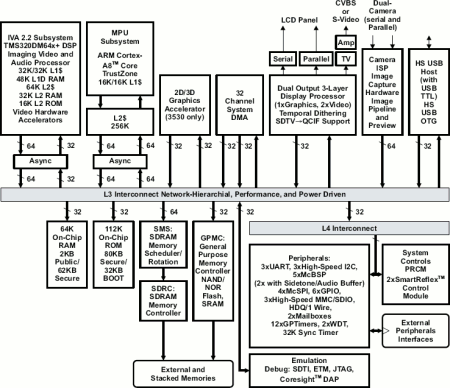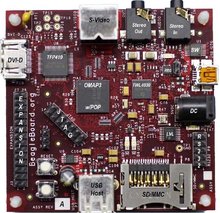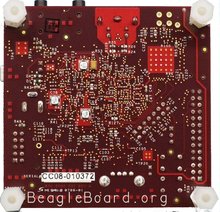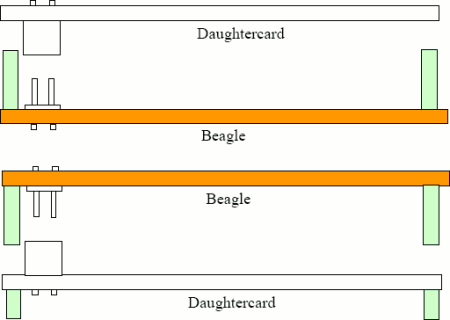$150 board sports Cortex-A8
Jun 9, 2008 — by LinuxDevices Staff — from the LinuxDevices Archive — 30 views A small group of Texas Instruments (TI) employees is readying a low-cost development board with an open hardware design. The $150 “Beagle Board” powers up over USB, and aims to provide embedded developers and hobbyists alike with access to the “highest performance ARM-based system-on-chip available today.”…
A small group of Texas Instruments (TI) employees is readying a low-cost development board with an open hardware design. The $150 “Beagle Board” powers up over USB, and aims to provide embedded developers and hobbyists alike with access to the “highest performance ARM-based system-on-chip available today.”…
The Beagle board is based on TI's OMAP3530 processor, the fanciest of TI's OMAP35xx portfolio, and one of the first available system-on-chip (SoC) processors based on ARM's Cortex-A8 processor core. Based in turn on a super-scaler, “dual-issue” micro-architecture, the Cortex-A8 core can double performance over similarly clocked SoCs that used earlier ARM architectures, ARM claimed when it unveiled the processor a couple of years ago. TI claimed up to 1200 Dhrystone MIPS for its early OMAP3 parts, lending some credence to ARM's claim that the processor would bring “desktop-like” performance to ultra-low-powered mobile devices (DMIPS PC comparison chart).

TI's OMAP3530 is the highest-end part
in TI's OMAP35xx family
(Click to enlarge)
Along with a 600MHz Cortex-A8 core, the OMAP3530 integrates TI's TMS320C64x core, a high-end DSP (digital signal processor) clocked at 430MHz. Onboard 2D/3D graphics are supplied by an Imagination SGX 2D/3D graphics processor supporting dual independent displays. All told, the chip closely resembles TI's newest, fastest applications processor for mobile phones, the OMAP34xx, but with a larger ball-pitch and lower-volume pricing, for use in embedded applications and less mainstream consumer electronics devices.


Beagleboard, top and bottom
(Click either view to enlarge)
The Beagle board is being designed essentially in ad hoc fashion by a small group of TI employees, under the aegis of TI's “small dreams” program. According to the Beagle board website, “'Small dreams' is an initiative at TI where employees with good ideas that don't necessarily require a large team are given a bit of funding to pursue their idea, in this case having a board fabricated and getting hosting for a website.”
The Beagle board is not yet in volume production. Currently a six-layer design, the goal is to streamline the design down to four layers, for greater reliability and especially to meet a target pricepoint of $150. However, prototypes have already been distributed to several Linux developers, who have worked to bootstrap Tux up onto the Beagle's back, so to speak. The group has already succeeded in demonstrating the Beagle running Angstrom Linux, and their work is being submitted to mainline, according to the blog of Koen Kooi. Kooi previously contributed to embedded projects that include Maemo and OpenEmbedded.
While awaiting mature, low-cost hardware and mainline Linux support, hardware hackers are welcome to draw from the Beagle project's 133-page hardware manual (PDF download) in designing and/or manufacturing a similar board of their own. The manual includes details electrical data, schematics, and mechanical drawings. ORCAD source files will also be available on the Beagleboard website, the project says.
What will this dog hunt?
What exactly does the Beagle board target? Actually, it would be easier to describe what it does not target, the Beagleboard.org website enthuses. Noting that the Beagle can run circles so to speak around the OLPC's LX800-based low-cost laptop design, the site lists potential applications that include:
- Low-cost Linux PC
- Network-connected digital signage
- 3D user interface development
- Game console
- LCD-to-picture-frame conversion kit
- Adobe Flash client “alarm clock” (like the Chumby)
- Kitchen computer
- Web services development
- Google Talk video phone
- Notebook TV-out via USB
- Projector media reader and presenter
- Gaming platform emulator
- Thin client terminal
- Web browser for the TV
- Multimedia codec and framework development
- Home networked media (DLNA/XMPP) server/client
- Security camera analyzer, streamer, recorder, and monitor
- USB traffic monitor (looks like a HUB)
- USB class conversion (add software support where drivers aren't available on the PC)
- Network sniffer
- Set-top box
Despite the flexibility of applications, the Beagle is apparently designed not to cut into sales of hardware reference designs from TI and its many hardware partners, such as Logic, which just launched an OMAP3-based medical device kit. That's because the Beagle board includes not a single peripheral of its own. Instead, it simply aims to enable the TI SoC's on-chip peripheral interfaces, by supplying the circuits needed to bring them out to real-world I/O connectors. Luckily, the OMAP3's interfaces include plenty of expansion, including high-speed (EHCI, theoretically 480Mbps) USB 2.0 and SDIO, which developers can use to add their own peripherals to the mix, the Beagle project says.
Project spokesperson Jason Kridner explains, “The Beagle Board is intended for those wanting to learn about building embedded systems and [who] don't need all of the support or costs associated with the typical development platform. Once you are done experimenting and need a silicon evaluation platform that will help you make a product, platforms with software compatibility are available.”
Hardware features
The Beagle is based on a PoP (package-on-package) sandwich combining TI's OMAP35xx processor with 128MB of 166MHz DDR RAM and 256MB of NAND Flash. Storage is expandable via a real SD/MMC+ slot onboard.

Package-on-package, with processor, flash, and RAM
The board eschews any device-specific LCD interface, in favor of DVI and DVI-D chips aimed at gluelessly supporting most any inexpensive display, the project says. The board boasts dual independent displays, including an HDMI connector that, with an HDMI-to-DVI cable, supports external flat-panel displays up to XGA (1024×768) at 65 MHz and 24-bit (“true-color”) pixel depth. There's also an S-video port.
Onboard I/O interfaces include:
- USB OTG (high-speed)
- USB 2.0 host port
- 9-pin RS-232 header
- Audio I/O with 1/8-inch stereo mini-jacks
- S-video port
- 14-pin JTAG
- Power LED, three software-controlled LEDs
- Reset and user-programmable buttons
The board includes several expansion interfaces, but the most interesting is a 28-pin connector near the board's edge. Carrying I2C, I2S, SPI, and MMC/SD signals, it can be used with top- and bottom-stacked daughtercards, as well as with offset daughtercards and ribbon cable connectors, the manual suggests.

Top- and bottom-stacked daughterboards.
Offset boards and ribbon cables are also possible
The Beagle measures 3-inches square. It can be powered over USB by a development host, and also features a 2.1mm input for an optional 5V, 500mA external power supply.
Lots more details are avialable on the BeagleBoard.org website, here. No target date for delivery has yet been set, as far as we can tell.
Thanks to Raphael Studer for calling this story to our attention
This article was originally published on LinuxDevices.com and has been donated to the open source community by QuinStreet Inc. Please visit LinuxToday.com for up-to-date news and articles about Linux and open source.